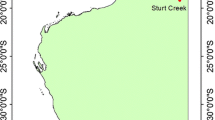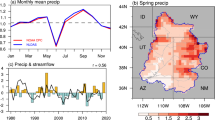Abstract
It is well known that El Niño-Southern Oscillation (ENSO) modifies precipitation patterns in several parts of the world. One of the most impacted areas is the western coast of South America, where Ecuador is located. El Niño events that occurred in 1982–1983, 1987–1988, 1991–1992, and 1997–1998 produced important positive rainfall anomalies in the coastal zone of Ecuador, bringing considerable damage to livelihoods, agriculture, and infrastructure. Operational climate forecasts in the region provide only seasonal scale (e.g., 3-month averages) information, but during ENSO events it is key for decision-makers to use reliable sub-seasonal scale forecasts, which at the present time are still non-existent in most parts of the world. This study analyzes the potential predictability of coastal Ecuador rainfall at monthly scale. Instead of the discrete approach that considers training models using only particular seasons, continuous (i.e., all available months are used) transfer function models are built using standard ENSO indices to explore rainfall forecast skill along the Ecuadorian coast and Galápagos Islands. The modeling approach considers a large-scale contribution, represented by the role of a sea-surface temperature index, and a local-scale contribution represented here via the use of previous precipitation observed in the same station. The study found that the Niño3 index is the best ENSO predictor of monthly coastal rainfall, with a lagged response varying from 0 months (simultaneous) for Galápagos up to 3 months for the continental locations considered. Model validation indicates that the skill is similar to the one obtained using principal component regression models for the same kind of experiments. It is suggested that the proposed approach could provide skillful rainfall forecasts at monthly scale for up to a few months in advance.













Similar content being viewed by others
References
Allan RJ (2000) ENSO And climatic variability in the Past 150 years. In: Díaz H.F., Markgraf (eds) El Niño and the Southern Oscillation: Multiscale Variability and Global and Regional Impacts. Cambridge University Press, p 496
Ashok K, Behera SK, Rao SA, Weng H (2007) El Niño Modoki and its possible teleconnection. J Geophys Res 112:C11007. doi:http://dx.doi.org/10.1029/2006JC003798
Barnston AG, Kumar A, Goddard L, Hoerling MP (2005) Improving seasonal prediction practices through attribution of climate variability, Bul. Am. Meteo. Soc., doi:10.1175/BAMS-86-1-59
Bendix J, Trachte K, Palacios E, RollenBecK R, Göttlicher D, Nauss T, Bendix A (2011) El Niño meets La Niña anomalous rainfall pattern in the traditional El Niño region of southern Ecuador. Erkunde 65(2):151–167. doi:10.3112/erdkunde.2011.02.04
Box GEP, Jenkins G, Reinsel GC (2008) Time series analysis: Forecasting and control. John Wiley, New Jersey
Castellano-Méndez M, González-Manteiga W, Febrero-Bande M, Prada-Sánchez JM, Lozano-Calderón R (2004) Modelling of the monthly and daily behavior of the runoff of the Xallas River using Box-Jenkins and neural networks methods. J Hydrol 296:38
EM-DAT (2014) The OFDA/CRED International Disaster Database: http://www.emdat.be
Enfield D, Mestas-Nuñez AM (2000) Global modes of ENSO and non-ENSO sea surface temperature variability and their associations with climate. In: Díaz H.F., Markgraf (eds) El niño and the southern oscillation: Multiscale variability and global and regional impacts. Cambridge University Press, p 496
Guenni L, Nobre C, Marengo J, Huerta G, Sansó B (2013) Oceanic influence on extreme rainfall. Comput Appl Math 1(2):7–45
Hastenrath S (1984) Interannual variability and the annual cycle: mechanisms of circulation and climate in the Tropical Atlantic sector. Mon Wea Rev 112:1097–1107
Hutchinson MF (1998) Interpolation of rainfall data with thin plate smoothing splines - Part I: two dimensional smoothing of data with short range correlation. J Geog Inf Dec Anal 2(2):139– 151
Hyndman R, Athanosopoulus G (2013) Forecasting: Principles and Practice, Open Access Books. Available on-line: https://www.otexts.org/fpp
Lagos P, Silva Y, Nickl E, Mosquera K (2008) El Niño-related precipitation variability in Perú. Adv Geosci 14:231–237
Mason SJ, Tippett MK (2016) Climate Predictability Tool version 15.3, Columbia University Academic Commons. doi:10.7916/D8NS0TQ6
Mo KC, Berbery EH (2011) Drought and persistent wet spells over South America based on observations and the U.S. CLIVAR drought experiments. J Clim 24(6):1801–1820. doi:10.1175/2010JCLI3874.1
Muñoz Á. G (2010) Coauthors an environmental watch system for the andean countries: el observatorio andino. Bull Amer Meteor Soc 91:1645–1652
Muñoz Á. G (2012) Coauthors risk management at the latin american observatory. In: Risk management current issues and challenges, chapter 22, ISBN: 978-953-51-744 0747-7
Muñoz Á. G (2014) Una metodología para definir índices ENOS para Ecuador basados en regímenes de circulación atmosférica y temperatura superficial del mar, Report written by the Center for Scientific Modeling (Venezuela) for the SENESCYT-INAMHI project SENESCYT-CGAJ-2013-0297-CO, 33pp. Available on-line: http://www.cmc.org.ve/portal/archivo.php?archivo=263
Muñoz Á.G., Goddard L, Robertson A, Kushnir Y, Baethgen W (2015) Cross-timescale interactions and rainfall extreme events in South East South America for the austral summer. Part I: Potential Predictors, J. Clim. doi:10.1175/JCLI-D-14-00693.1
Ni Q, Wang L, Zheng B, Sivakumar M (2012) Evolutionary algorithm for water storage forecasting response to climate change with small data sets: the Wolonghu Wetland, China. Environ Eng Sci 29(8):814–820
Pineda L, Ntegeka V, Willems P (2013) Rainfall variability related to sea surface temperature anomalies in a PacificAndean basin into Ecuador and Peru. Adv Geosci 33:53–62. doi:10.5194/adgeo-33-53-2013
Poveda G, Waylen PR, Pulwarty RS (2006) Annual and inter-annual variability of the present climate in northern South America and southern Mesoamerica, Palaeogeography, Palaeoclimatology. Palaeoecology 234(1):3–27
Purca S (2007) Variabilidad temporal de baja frecuencia en el Ecosistema de la Corriente Humboldt frente a Perú. Tesis de Doctorado. Universidad de Concepción, Chile
Quispe C, Purca S (2007) Previsión de la temperatura superficial del mar frente a la costa Peruana mediante un modelo autorregresivo integrado de media móvil. Rev Peru Biol 14(1):109–115
Quispe C, Tam J, Saavedra M, Gozález I (2009) Índice basado en presiones atmosféricas para la detección de efectos de El Niño y la Oscilación del Sur frente a la costa Peruana. Rev Peru Biol 15(2):137–140
R Core Team. R (2014) A language and environment for statistical computing. R Foundation for Statistical Computing, Vienna, Austria . http://www.R-project.org/
Recalde-Coronel GC, Barnston AG, Muñoz AG (2014) Predictability of December-April Rainfall in Coastal and Andean Ecuador, J. Appl. Meteor. Climatol. doi:10.1175/JAMC-D-13-0133.1
Rodríguez-Rubio E (2013) Multivariate climate index for western coast of Colombia. Adv Geosci 33:21–26
Rossel F, Goulven P, Cadier E (1999) Areal distribution of the influence of ENSO on the annual rainfall in Ecuador, Revue des Sciences del L’EAU. Rev Sci Eau 12(1):183–200
Sachs J, Ladd SN, Cole E, Goyes P, Manzello D, Martinez R, Palacios C, Vecchi GA, Xie L (2010) Climate and ocenography of the Galápagos in the 21st century: expected changes and research needs. Galápagos Res 67:50–51
Shumway RH, Stoffer DS (2011) Time series analysis and its applications, with R examples. Springer, New York
Singh A, Delcroix T, Cravatte S (2011) Contrasting the flavors of El Nio-Southern Oscillation using sea surface salinity observations. J Geophys Res 116:C06016. doi:10.1029/2010JC006862
Vaughan C, Dessai S (2014) Climate services for society: origins, institutional arrangements, and design elements for an evaluation framework, WIREs Clim Change. doi:10.1002/wcc.290
Vuille M, Bradley RS, Keimig F (2000) Climate variability in the Andes of Ecuador and its relation to tropical Pacific and Atlantic sea surface temperature anoMalies. J Clim 13:2520–2535
Webster PJ, Hoyos C (2004) Prediction of Monsoon rainfall and river discharge on 15-30-day time scales. doi:10.1175/BAMS-85-11-1745
Zebiak SE, Orlove B, Vaughn C, Munoz A, Hansen J, Troy T, Thomson M, Lustig A, Garvin S (2014) Discovering ENSO and Society Relationships, Climate Change (Wiley Interdisciplinary Reviews)
Acknowledgments
We are grateful to the Secretaria Nacional de Ciencia y Tecnologia (SENESCYT) of Ecuador, for funding this project (SENESCYT-CGAJ-2013-0297-CO). We also acknowledge the Prometeo Programme of SENESCYT, under which the first author was funded for her stay at Escuela Superior Politécnica del Litoral (ESPOL) during the period Jan–Sep 2014. We are grateful to Instituto Nacional Oceanográfico de la Armada (INOCAR) for providing the required data to develop this research, and the technical team of Instituto Nacional de Meteorología e Hidrología (INAMHI), the Latin American Observatory of Climate Events, and Centro de Modelado Científico of Zulia University for detailed discussions on the subject.
Author information
Authors and Affiliations
Corresponding author
Additional information
This institute is part of the Latin American Observatory (http://ole2.org)
Rights and permissions
About this article
Cite this article
de Guenni, L.B., García, M., Muñoz, Á.G. et al. Predicting monthly precipitation along coastal Ecuador: ENSO and transfer function models. Theor Appl Climatol 129, 1059–1073 (2017). https://doi.org/10.1007/s00704-016-1828-4
Received:
Accepted:
Published:
Issue Date:
DOI: https://doi.org/10.1007/s00704-016-1828-4




